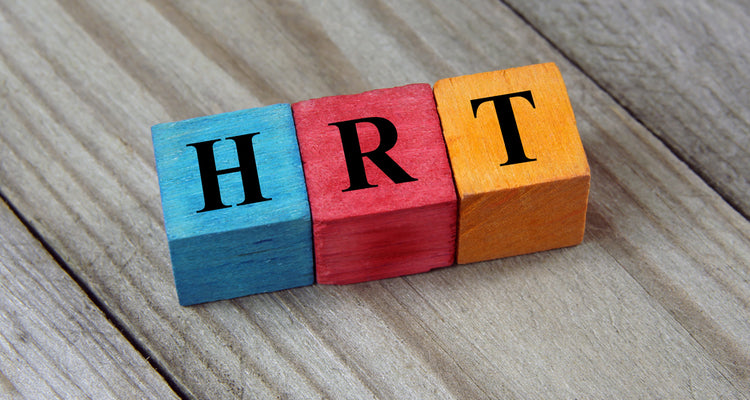The menopause is influenced by changes in hormone levels, particularly oestrogen. During a woman’s fertile years, oestrogen is produced predominantly in the ovaries and controls the reproductive cycle and subsequent menstruation or pregnancies. As women get older, the oestrogen levels will decrease gradually, which causes the body to physically react. This results in women having to deal with an array of unpleasant symptoms such as hot flushes, joint and muscle pain, urinary and vaginal issues. Hormone Replacement Therapy (HRT) is one treatment option which our Pharmacist Lisa Coffey takes us through in this blog.

What is HRT?
Hormone Replacement Therapy (HRT) does exactly what it says on the tin. It is a treatment that literally replaces the hormones being lost and as a result helps manage the symptoms of the menopause. HRT is the most evidence-based intervention for symptom control. It is recommended a woman go on HRT at the lowest possible dose and for the shortest amount of time possible.
The two main hormones involved in HRT are Oestrogen and Progestogen:
- Oestrogen gives relief from menopausal symptoms however can lead to an increase in incidence of endometrial hyperplasia.
- Progestogen is added in to significantly reduce the incidence of the endometrial hyperplasia and in turn will decrease the incidence of endometrial cancer.
There are different types of HRT that a Doctor can prescribe and this will vary on a case-by-case basis; a combined Oestrogen-Progestogen therapy or an Oestrogen only therapy. Oestrogen-only therapy is only suitable for women who have either undergone a hysterectomy or who have the Mirena coil in situ. Women who have had a hysterectomy no longer have a womb and so, no longer have an endometrium. Therefore the risk of increased endometrial hyperplasia associated with oestrogen only therapy is not a concern. The Mirena coil contains a progestogen hormone called Levonorgestrel. It will provide enough progestogen protection to be used in combination with oestrogen only treatments.
Types of HRT Available
1. Oral Formulations
For Oestrogen-Progestogen therapy there are two types of oral formulations available. Sequential combined preparations or continuous combined preparations.
Sequential Combined Preparations:
- Example: Novofem.
- They mimic the menstrual cycle and result in a monthly bleed.
- An oestrogen tablet is taken once daily for 28days (with no break) and then for the last 12-14 days, progestogen is added.
- Women get a withdrawal bleed around 2 days after stopping the progestogen
- Typically recommended for woman who are peri-menopausal and still getting monthly periods
Continuous Combined Preparations
- Example: Femoston-Conti
- Oestrogen and Progestogen taken together once daily in one combined tablet.
- It is a “bleed-free” regimen. In the early stages of this treatment, intermittent spotting can occur however this should settle after taking the tablets for a few months.
- There is a lower level of progestogen in the continuous combined preparations as it is being taken every day unlike in the sequential combined preparation where it is taken in the last 12-14 days.
- These preparations should only be used by women who are post-menopausal i.e. women who have had no period for 12months or more. This is not a suitable treatment for peri-menopausal women
Oestrogen-only Preparations
- Example Fematab
- Very important that these are only used in women who have had a hysterectomy or women with the Mirena coil in situ
- One tablet daily
2. Transdermal Preparations
Examples:
- Evorel Conti transdermal patch (combined oestrogen and progestogen)
- Estradot transdermal patch (oestrogen only)
- Divigel (oestrogen only transdermal gel)
The transdermal options can be in the form of a patch or a gel. They are not associated with an increased risk of stroke or VTE. Therefore, they are considered first-line options for women who have an increased risk of cardiovascular events, women who have a BMI of greater than 30 and women who smoke.
These are also a great option for women who:
- are unable to tolerate the oral preparations and experience side effects from the oral oestrogen such as gastrointestinal upset (nausea).
- those who have bowel disorders which may affect the absorption of the oral treatment.
- those with a history of migraine. The patches have a steadier release of the hormones and this can be beneficial in women where hormonal changes trigger a migraine.
- those who have a lactose sensitivity. Most of the oral preparations contain lactose.
- women on medicines that are hepatic enzyme inducers.
How do the patches work?
The transdermal patch provides a steady supply of hormone and there should be no break between the packs. For a month supply, you receive 8 patches.
The patches are to be applied twice weekly, on the same days each week. If you apply the first patch on Monday, you will remove it on Thursday and apply a fresh patch, then the following Monday you will remove the patch and apply a new one.
It should be worn on a hairless area, below the waist e.g. the thigh or bottom. DO NOT apply the patch anywhere near the breasts. Every time you apply a new patch, change the location of it so as not to cause any local irritation of the skin. Simply changing from right leg to left leg is sufficient.
The patches can be worn as normal in the shower, the bath, during swimming/ general exercise, without being affected. It is advised to cover them when sunbathing, as they should not be in direct sunlight.

How do the transdermal gels work?
Divigel is an oestrogen-only gel, so only suitable for those with a hysterectomy or with the Mirena coil in situ. It is to be rubbed on once daily to the lower trunk or on the thigh. Just like the patches, the woman must change the location daily she applies to gel to. DO NOT apply anywhere near the breasts.
3. Vaginal Oestrogen
Oestrogen deficiency can result in vaginal atrophy, decreases in vaginal blood flow and secretions. These urogenital symptoms can lead to a lot of discomfort for the woman on a daily basis and also during sexual intercourse. Vaginal oestrogen in the form of a pessary can be used to help alleviate these symptoms. Vaginal oestrogen works locally in the vagina and will not help with any of the vasomotor symptoms like hot flushes.
Side Effects of HRT
Women can experience some symptoms during the first month or two of their treatment however this usually settles within 3 months of initiation. It is important to keep in contact with your Pharmacist or G.P. if these symptoms are not tolerable.
Side effects can be caused by both Oestrogen and Progestogen. Oestrogen side effects can include:
- Breast tenderness
- Leg cramps
- Bloating
- Nausea
- Headache
Solutions: evening primrose oil is useful for alleviating breast tenderness. If women have nausea when taking their oral HRT, it is recommended to take with or after food. If the nausea is too much, then it may be an option to speak to the G.P. to change to a different form of HRT, like the transdermal patch.
Progestogen side effects can include:
- PMS type symptoms
- Breast tenderness
- Backache headache
- Acne (greasy/oily skin)
- Depressed mood.
Solutions: evening primrose oil is useful for alleviating breast tenderness, heat packs and Epsom salt baths provide relief for back and abdominal pains, changing skincare regimens is helpful for the excess oil being produced by the skin.
Bleeding can be a common side effect of HRT experienced usually for three months of initiation of treatment. If it continues for longer than that it is important to speak to your G.P or Pharmacist about it just to rule out anything more sinister.
Contraindications for HRT
Contraindications for HRT include:
- Abnormal undiagnosed vaginal bleeding- can get break through bleeds during initiation of treatment however this normally stops within the first 3 months. If this continues and the reason is unknown, then further investigation needs to be carried out to rule out anything more sinister.
- Breast carcinoma
- Endometrial carcinoma
- Sever liver dysfunction
- Previous or current Venous Thromboembolism (Pulmonary embolism or Deep Vein Thrombosis)
- Active or recent arterial thromboembolic disease
Benefits & Risks of Taking HRT
Please discuss in detail with G.P.
Risk of Breast Cancer:
Many women and their family members are concerned about the link between HRT and cancer. This is a topic that receives a lot of media coverage. Studies show that for women around menopausal age:
-
Oestrogen‑only HRT causes little or no change in the risk of breast cancer.
-
HRT that contains oestrogen and progestogen may increase breast cancer risk. This risk may be higher if you take HRT for longer but falls again when you stop taking HRT.
HRT is thought to be a promoter of breast cancer cells rather than an initiator. The baseline risk of breast cancer varies according to a range of risk factors such as family history, obesity, alcohol consumption. Women on HRT should be advised to stay vigilant for any changes in the breasts. and to carry out regular breast examines on themselves. Great references for guidance on how to correctly do these checks is the Marie Keating website or on the HSE website. Ensure you are regularly attending breast screenings.
Risk of Endometrial Cancer:
There is an increased risk of endometrial cancer as oestrogen can increase the incidence of endometrial hyperplasia. However, this is why the progestogen is used in combination with oestrogen. The progestogen reduces the risk of endometrial cancer.
Risk of Venous Thromboembolism:
HRT tablets (but not patches or gels) are linked with a higher risk of developing a blood clot. If you are already at higher risk of blood clots (for example, you are obese) and you are considering HRT, you may be offered patches or gel rather than tablets. If you have a strong family history of blood clots or if there's another reason why you are at high risk of blood clots, you may be referred to a haematologist (a doctor who specialises in blood conditions) before considering HRT.
Osteoporosis
When your ovaries stop making oestrogen your bones become thinner and you have a higher risk of osteoporosis, where your bones break more easily. You should be given advice about bone health and osteoporosis at your first appointment and again when reviewing your treatment. Your GP should explain that for women around menopausal age the risk of breaking a bone is low, and HRT reduces this risk further. This benefit only lasts while you are taking HRT but it may last longer if you have taken HRT for a long time.
Contraception and the Menopause
Women should not rely on HRT as a form of contraception. Women under 50 years are still considered fertile 2 years after their last menstrual period and women over 50 years are still considered fertile 1 year after their last menstrual period.
IUD’s (Mirena Coil), progesterone only pills and barrier methods (e.g. condoms) are considered the most suitable forms of contraception. It is recommended that for women over 50, all combined contraceptive pills should be discontinued and replaced by one of the options above.

The role of the Mirena Coil in the Menopause:
- The Mirena coil is a hormonal inter-uterine device.
- Its primary indication is as a contraceptive however its secondary indication is for use in the menopause.
- Levonorgestrel is the active ingredient in the Mirena coil. This is a progestogen hormone. Therefore, it acts as protection against endometrial hyperplasia when using HRT. It can be used in combination with oestrogen only formulations of HRT.
- Mirena coil is a good option for woman needing to still use contraception and also wanting to start HRT. If it is being used for contraceptive purposes during the menopause, it is important that it is changed every 5 years. If it is just being used to deal with heavy bleeding, then its use can be extended but the patient must be made aware that it will not be an effective form of contraception after 5years.
- 65% of women using the Mirena Coil will achieve amenorrhea (i.e. no periods) within 1year of it being in-situ, so it can be offered as a “bleed-free option of HRT which some women prefer.
Thyroid and Menopause
There really isn’t much information on the link between Thyroid and Menopause. It is more so that some symptoms experienced in the menopause can be similar to those seen in thyroid dysfunction:
- Hypothyroidism or an under active thyroid -fatigue, lethargy, weight gain, dry skin and hair, low mood, impaired concentration
- Hyperthyroidism or an overactive thyroid-fatigue, sweating, heat intolerance, weight loss, difficulty sleeping, palpitations, anxiety.
In general, women are 10 times more likely to suffer from thyroid disease than men. It would be common for women to attribute all the above symptoms to the menopause. It may be advisable to get a blood test to check thyroid function, to rule out thyroid dysfunction
With regards to HRT treatment and thyroid function:
- Women who have no pre-existing thyroid disorder and have a normal thyroid function normally adapt well to HRT and the thyroid function remains the same.
- Woman who have pre-existing hypothyroidism (underactive) and are being treated with thyroxine (brand name = Eltroxin) may require an increase in their thyroxine dose after initiating HRT. It is recommended to have thyroid function re-checked after starting HRT.
Our team are here to help in any way that we can. If you have any questions on this or would like to discuss this with a member of our expert pharmacy team, please contact our helpline on 01 485 3098 or email help@meagherspharmacy.ie.



